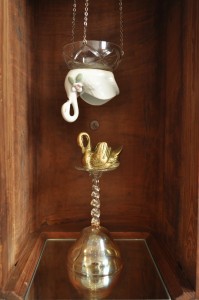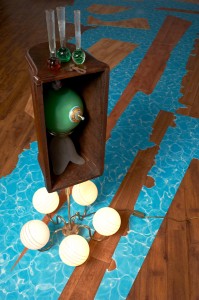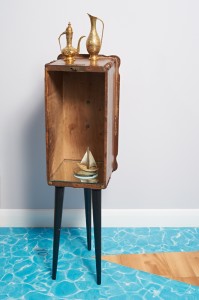‘No man is an island / Entire of itself’
(John Donne, ‘Meditation XVII’)
Small Islands allows its viewers a pathway through a small but tall gallery space, distracting and attracting them on one wall with a colony of luminous jellyfish, lights made of glass jelly-molds and lemon-juice squeezers, and on their other side with a group of wooden boxes, nicely turned out in their furniture legs and personalised with various objects. With its wall lights and lots of warmly wooden furniture, the space is like an improvised living room. Its cosy clutter and gentle lighting is, however, dissipated, lost in space, as the disproportionately high ceiling and windows lift the lid on the room, opening it out into a little world. Our path through the space is like a strand, from which we discover strange objects from a watery world, jelly-fish and drift-wood creatures, which seem to have tumbled off some Ship of Fools in an obscure time and place. Contrasted with the creatures of light and glass, the wooden boxes are warm and organic, sociable but semi-detached, each with its own territory of selfhood. Affable but insular on their little islands, each box is separated from the others by a patch of water and its quirky individuality.
As we walk by and look at each of them, the boxes become recognisable as people like us. A little austere, certainly, but nonetheless cute critters, with their big wooden heads and various, rather comic, legs. Every man is an island here, marked by the patch of floorboards it stands upon. Literalising the contemporary cliché of ‘head space,’ one side of each box is open, its whole face a window to the soul. We can accordingly look inside these box-heads and read their minds and characters. One box, evidently having undergone a process of regeneration, contains a sloughed-off snakeskin. Many others contain mirrors, which are the basic mechanism and metaphor for the mind here. Most look reflectively out to us with their mirrors, so they seem to register our presence and transparently offer back partial images of us and other things around them. Some have more elaborate double mirrors, with several of these being contained by smaller boxes within the larger. These compartments literalise the metaphor of mental reflection, which was originally made by the philosopher John Locke, who in his An Essay Concerning Human Understanding (1689) argues that all our ideas come from either reflection, ‘the internal operations of our minds, perceived and reflected on by ourselves,’ or sensation, the mind’s observation of the impressions that external objects make upon it through the senses. Some outward facing mirrors faithfully duplicate the appearances of the world before them, while, a mechanism for mental reflection, the double mirrors make further reflections of them within their boxes, (indeed they picture internal consciousness as a mise-en-abyme, as from a certain angle, images bounce back and forth from one mirror to the other, endlessly . . .). One box, with a smaller double-mirrored box within it, further demonstrates the metaphor of mental reflection with a metal plate used for printing a 1950s newspaper advertisement for ‘Dryway Monarch weathercoats,’ its negative image made positive by the mirror it sits upon at the base of the box. Another box dramatises such reflection sculpturally by hanging a glass bowl with an upside-down porcelain swan underneath, while correspondingly below this pair is another swan sitting on an inverted champagne glass, the whole thing being further reflected by the mirror base they are sitting on. One more, self-contained and solipsistic, box has adapted its mental-mirror apparatus to have only an oblique relation to the outside world. Its little round mirror is horizontal on the inside of the base of the box, having become a little pond upon which plays a small sail-boat, while clues to this happy state of mind are given by the brass Turkish coffee pot and jug sitting on top of the box, which suggest oriental languor and mild means of achieving contented or altered states of consciousness.
Another of the Small Islands displays long shapely white legs and has a matching white porcelain hand emerging from the top of its box, like ‘Thing’ does in the Addams Family. Having been expressly made for the purpose of holding rings, the hand is outstretched accommodatingly, offering itself to another. Evidently belonging to a Lady, it will be completed by an engagement and a wedding ring, and the clasp of another: it is a hand-in-marriage. Within it, placed on a skin-coloured cushion, are two objects. One is an ivory glove-stretcher, the means by which the hand can be most closely fitted into leather gloves, as it works to attract a partner. Next to it, a lady’s hand-mirror flirtatiously offers decorously framed images of those who look at her. The contents of her mind, within the box, are an open book, for its interior surfaces are covered with a two-page spread from a 1950s women’s magazine, consisting of an article entitled ‘Bouquets in Unusual Containers,’ alongside an informative advertisement for Pearson’s Enquire Within. This indicates the encyclopaedic nature of her mind, but also its restricted range, being largely limited to domestic topics. Pearson’s Enquire Within was the most recent incarnation of the great Victorian best-seller, Enquire Within Upon Everything, which offered recipes, ways of renovating clothes, advice about manners, and all manner of helpful household hints, along with random general knowledge facts, running in small italicised print at the bottom of each page. This charming domestic goddess highlights the nature and rationale of her species as collocations of objets trouvés from mid-twentieth century middle-class homes, sedately and surreally invoking Victorian domesticity with their classy turned-furniture legs and knick-knackery. They are like three-dimensional counterparts to Max Ernst’s collages for his pictorial novel Une Semaine de Bonté (1934), which cuts and pastes illustrations from Victorian books to form bizarre dream-like juxtapositions — or indeed nineteenth-century precursors to such surrealist images, which assembled images of people from the consumerist objects they bought. The prime example of this genre is Grandville’s ‘Fashionable people represented in public by their accoutrements’ (1844), in which, dispensing with the middle (class) men and women, various assemblages of hats, bonnets, coats, gloves, pipes and boots gather to admire, and socialise with, one another. Like the Grandville figures, the Small Islands, are entirely composed of remnant consumer objects, by commodity fetishism, whereby the relations between human beings, social relations, are displaced to goods, to commodities. Another box is topped by a wooden tiara, while the one containing the reflective swans deploys a silver serviette holder, a la Pippa Middleton, as an alluring ‘fascinator.’ Complementing such tall and elegant femme fatales, and likely to fall victim to them if he is not careful, is a short long box on squat muscley table legs, containing a pair of pliers and a simple single mirror. Small Islands invites us to get our toes wet and meet a community of sympathetic, if rather wooden, characters.
2013, Dr Daniel Brown, senior lecturer in English Literature, Southampton University


